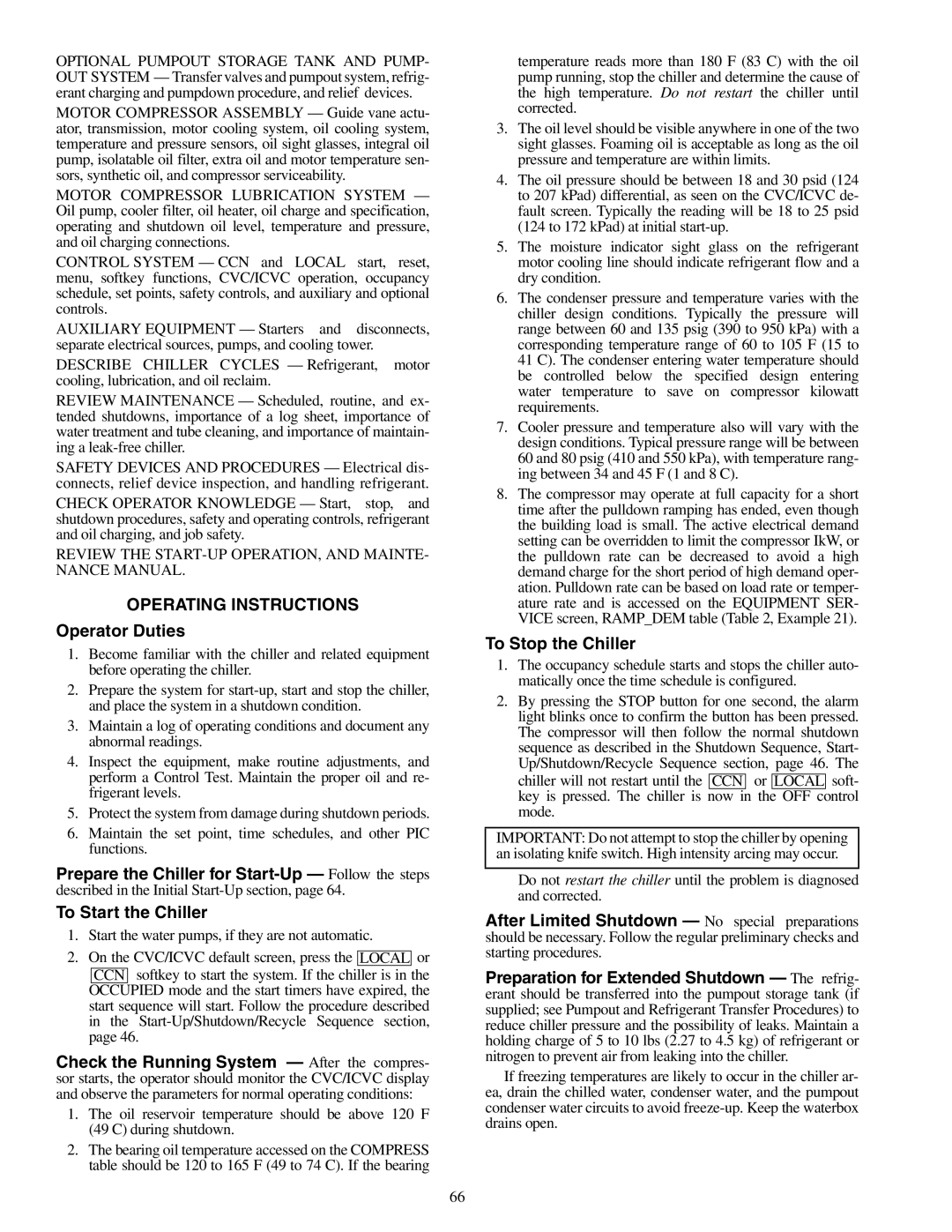OPTIONAL PUMPOUT STORAGE TANK AND PUMP- OUT SYSTEM — Transfer valves and pumpout system, refrig- erant charging and pumpdown procedure, and relief devices.
MOTOR COMPRESSOR ASSEMBLY — Guide vane actu- ator, transmission, motor cooling system, oil cooling system, temperature and pressure sensors, oil sight glasses, integral oil pump, isolatable oil filter, extra oil and motor temperature sen- sors, synthetic oil, and compressor serviceability.
MOTOR COMPRESSOR LUBRICATION SYSTEM — Oil pump, cooler filter, oil heater, oil charge and specification, operating and shutdown oil level, temperature and pressure, and oil charging connections.
CONTROL SYSTEM — CCN and LOCAL start, reset, menu, softkey functions, CVC/ICVC operation, occupancy schedule, set points, safety controls, and auxiliary and optional controls.
AUXILIARY EQUIPMENT — Starters and disconnects, separate electrical sources, pumps, and cooling tower.
DESCRIBE CHILLER CYCLES — Refrigerant, motor cooling, lubrication, and oil reclaim.
REVIEW MAINTENANCE — Scheduled, routine, and ex- tended shutdowns, importance of a log sheet, importance of water treatment and tube cleaning, and importance of maintain- ing a leak-free chiller.
SAFETY DEVICES AND PROCEDURES — Electrical dis- connects, relief device inspection, and handling refrigerant.
CHECK OPERATOR KNOWLEDGE — Start, stop, and shutdown procedures, safety and operating controls, refrigerant and oil charging, and job safety.
REVIEW THE START-UP OPERATION, AND MAINTE- NANCE MANUAL.
OPERATING INSTRUCTIONS
Operator Duties
1.Become familiar with the chiller and related equipment before operating the chiller.
2.Prepare the system for start-up, start and stop the chiller, and place the system in a shutdown condition.
3.Maintain a log of operating conditions and document any abnormal readings.
4.Inspect the equipment, make routine adjustments, and perform a Control Test. Maintain the proper oil and re- frigerant levels.
5.Protect the system from damage during shutdown periods.
6.Maintain the set point, time schedules, and other PIC functions.
Prepare the Chiller for Start-Up — Follow the steps described in the Initial Start-Up section, page 64.
To Start the Chiller
1.Start the water pumps, if they are not automatic.
2.On the CVC/ICVC default screen, press the LOCAL or
CCN softkey to start the system. If the chiller is in the OCCUPIED mode and the start timers have expired, the start sequence will start. Follow the procedure described in the Start-Up/Shutdown/Recycle Sequence section, page 46.
Check the Running System — After the compres- sor starts, the operator should monitor the CVC/ICVC display and observe the parameters for normal operating conditions:
1.The oil reservoir temperature should be above 120 F (49 C) during shutdown.
2.The bearing oil temperature accessed on the COMPRESS table should be 120 to 165 F (49 to 74 C). If the bearing
temperature reads more than 180 F (83 C) with the oil pump running, stop the chiller and determine the cause of the high temperature. Do not restart the chiller until corrected.
3.The oil level should be visible anywhere in one of the two sight glasses. Foaming oil is acceptable as long as the oil pressure and temperature are within limits.
4.The oil pressure should be between 18 and 30 psid (124 to 207 kPad) differential, as seen on the CVC/ICVC de- fault screen. Typically the reading will be 18 to 25 psid (124 to 172 kPad) at initial start-up.
5.The moisture indicator sight glass on the refrigerant motor cooling line should indicate refrigerant flow and a dry condition.
6.The condenser pressure and temperature varies with the chiller design conditions. Typically the pressure will range between 60 and 135 psig (390 to 950 kPa) with a corresponding temperature range of 60 to 105 F (15 to 41 C). The condenser entering water temperature should be controlled below the specified design entering water temperature to save on compressor kilowatt requirements.
7.Cooler pressure and temperature also will vary with the design conditions. Typical pressure range will be between 60 and 80 psig (410 and 550 kPa), with temperature rang- ing between 34 and 45 F (1 and 8 C).
8.The compressor may operate at full capacity for a short time after the pulldown ramping has ended, even though the building load is small. The active electrical demand setting can be overridden to limit the compressor IkW, or the pulldown rate can be decreased to avoid a high demand charge for the short period of high demand oper- ation. Pulldown rate can be based on load rate or temper- ature rate and is accessed on the EQUIPMENT SER- VICE screen, RAMP_DEM table (Table 2, Example 21).
To Stop the Chiller
1.The occupancy schedule starts and stops the chiller auto- matically once the time schedule is configured.
2.By pressing the STOP button for one second, the alarm light blinks once to confirm the button has been pressed. The compressor will then follow the normal shutdown sequence as described in the Shutdown Sequence, Start- Up/Shutdown/Recycle Sequence section, page 46. The
chiller will not restart until the CCN or LOCAL soft- key is pressed. The chiller is now in the OFF control mode.
IMPORTANT: Do not attempt to stop the chiller by opening an isolating knife switch. High intensity arcing may occur.
Do not restart the chiller until the problem is diagnosed and corrected.
After Limited Shutdown — No special preparations should be necessary. Follow the regular preliminary checks and starting procedures.
Preparation for Extended Shutdown — The refrig- erant should be transferred into the pumpout storage tank (if supplied; see Pumpout and Refrigerant Transfer Procedures) to reduce chiller pressure and the possibility of leaks. Maintain a holding charge of 5 to 10 lbs (2.27 to 4.5 kg) of refrigerant or nitrogen to prevent air from leaking into the chiller.
If freezing temperatures are likely to occur in the chiller ar- ea, drain the chilled water, condenser water, and the pumpout condenser water circuits to avoid freeze-up. Keep the waterbox drains open.

